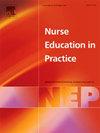护理学生在线学习中自我调节与参与的潜在特征分析
IF 3.3
3区 医学
Q1 NURSING
引用次数: 0
摘要
目的探讨护生在线自我调节学习(SRL)的不同特征,并探讨其人口学变量和在线学习参与度的差异。许多学生通过网络课程进行学习,他们在学习过程中的自我调节影响了他们的参与度和学习质量。识别在线SRL配置文件可以帮助计划和执行在线学习活动。设计横断面调查研究。方法研究于2021年3月22日至28日在中国福州一所高职院校的676名护理专业学生中进行。采用在线自主学习问卷和远程教育学生参与度问卷对学生自主学习能力和参与度进行评估。进行了潜在剖面分析和多项逻辑回归。结果护生在线学习自我调节模式分为“有限在线学习能力”(n = 234)、“中等在线学习能力”(n = 408)和“优秀在线学习能力”(n = 34)。回归分析显示,年级、选择护理专业的主要原因、职业认同程度等类别间差异有统计学意义(P <; 0.05),性别、原籍地、家庭经济状况等类别间差异无统计学意义(P <; 0.05)。在线SRL能力越强,在线学习投入水平越高(P <; 0.05)。结论不同类别护生的部分人口学变量分布存在差异,针对不同类别护生的不同特征采取相应的干预措施有助于提高在线学习能力,促进在线学习投入水平。本文章由计算机程序翻译,如有差异,请以英文原文为准。
A latent profile analysis of self-regulation associated with engagement in online learning among nursing students
Aim
To identify different online self-regulation learning (SRL) profiles among nursing students and to explore differences in demographic variables and online learning engagement among the profiles.
Background
Many students study via online classes and their self-regulation during learning had an impact on their engagement and learning quality. Identifying online SRL profiles could aid in planning and executing online learning activities.
Design
A cross-sectional survey study.
Methods
The study involved 676 nursing students from a higher vocational college in Fuzhou, China, between March 22 and 28, 2021. The Online Self-regulated Learning Questionnaire and the Student Engagement in Distance Education Questionnaire were used to assess SRL and engagement. Latent profile analysis and multinomial logistic regression were performed.
Results
The patterns of self-regulation in online learning among nursing students were categorized as “limited online SRL ability” (n = 234), “moderate online SRL ability” (n = 408) and “superior online SRL ability” (n = 34). A regression analysis indicated statistically significant inter-category differences in grade, main reasons for choosing nursing as a major and degree of professional identity (P < 0.05) and no significant inter-category differences in sex, place of origin and family economic status (P > 0.05). The stronger the online SRL ability, the higher the level of online learning engagement (P < 0.05).
Conclusion
The distribution of some demographic variables showed differences among different categories of nursing students and intervention measures corresponding to the different characteristics of each category may help improve online SRL ability and promote the level of online learning engagement.
求助全文
通过发布文献求助,成功后即可免费获取论文全文。
去求助
来源期刊

Nurse Education in Practice
NURSING-
CiteScore
5.40
自引率
9.40%
发文量
180
审稿时长
51 days
期刊介绍:
Nurse Education in Practice enables lecturers and practitioners to both share and disseminate evidence that demonstrates the actual practice of education as it is experienced in the realities of their respective work environments. It is supportive of new authors and will be at the forefront in publishing individual and collaborative papers that demonstrate the link between education and practice.
 求助内容:
求助内容: 应助结果提醒方式:
应助结果提醒方式:


